
A tank destroyer, tank hunter or tank killer is a type of armoured fighting vehicle, predominantly intended for anti-tank duties. They are typically armed with a direct fire artillery gun, also known as a self-propelled anti-tank gun, or missile launcher, also called an anti-tank missile carrier. The vehicles are designed specifically to engage and destroy enemy tanks, often with limited operational capacities.

The M4 Sherman, officially Medium Tank, M4, was the most widely used medium tank by the United States and Western Allies in World War II. The M4 Sherman proved to be reliable, relatively cheap to produce, and available in great numbers. It was also the basis of several other armored fighting vehicles including self-propelled artillery, tank destroyers, and armored recovery vehicles. Tens of thousands were distributed through the Lend-Lease program to the British Commonwealth and Soviet Union. The tank was named by the British after the American Civil War General William Tecumseh Sherman.
This page details tank production by the United States of America during World War II.

The M3 Lee, officially Medium Tank, M3, was an American medium tank used during World War II. The turret was produced in two forms, one for US needs and one modified to British requirements to place the radio next to the commander. In British Commonwealth service, the tank was called by two names: tanks employing US-pattern turrets were called "Lee", named after Confederate general Robert E. Lee, while those with British-pattern turrets were known as "Grant", named after Union general Ulysses S. Grant.

An anti-tank gun is a form of artillery designed to destroy tanks and other armoured fighting vehicles, normally from a static defensive position. The development of specialized anti-tank munitions and anti-tank guns was prompted by the appearance of tanks during World War I. To destroy hostile tanks, artillerymen often used field guns depressed to fire directly at their targets, but this practice expended too much valuable ammunition and was of increasingly limited effectiveness as tank armor became thicker. The first dedicated anti-tank artillery began appearing in the 1920s, and by World War II was a common appearance in many European armies. To penetrate armor, they fired specialized ammunition from longer barrels to achieve a higher muzzle velocity than field guns. Most anti-tank guns were developed in the 1930s as improvements in tanks were noted, and nearly every major arms manufacturer produced one type or another.

The M36 tank destroyer, formally 90 mm Gun Motor Carriage, M36, was an American tank destroyer used during World War II. The M36 combined the hull of the M10 tank destroyer, which used the M4 Sherman's reliable chassis and drivetrain combined with sloped armor, and a new turret mounting the 90 mm gun M3. Conceived in 1943, the M36 first served in combat in Europe in October 1944, where it partially replaced the M10 tank destroyer. It also saw use in the Korean War, where it was able to defeat any of the Soviet tanks used in that conflict. Some were supplied to South Korea as part of the Military Assistance Program and served for years, as did re-engined examples found in Yugoslavia, which operated into the 1990s. Two remained in service with the Republic of China Army at least until 2001.

The M18 Hellcat is a tank destroyer used by the United States Army in World War II and the Korean War. Despite being equipped with the same main gun as some variants of the much larger Sherman tank, the M18 attained a much higher top speed of up to 55 mph (89 km/h) by keeping armor to a minimum, and using the innovative Torqmatic automatic transmission.

The M10 tank destroyer, formally 3-inch Gun Motor Carriage M10, or M10 GMC was an American tank destroyer of World War II. After US entry into World War II and the formation of the Tank Destroyer Force, a suitable vehicle was needed to equip the new battalions. By November 1941, the Army requested a vehicle with a gun in a fully rotating turret after other interim models were criticized for being too poorly designed. The prototype of the M10 was conceived in early 1942 and delivered in April that year. After appropriate changes to the hull and turret were made, the modified version was selected for production in June 1942 as the "3-inch Gun Motor Carriage M10". It mounted the 3-inch gun M7 in a rotating turret on a modified M4 Sherman tank chassis.

The Ordnance Quick-Firing 6-pounder 7 cwt, or just 6-pounder, was a British 57 mm gun, serving during the Second World War as a primary anti-tank gun of both the British and United States Army. It was also used as the main armament for a number of armoured fighting vehicles.
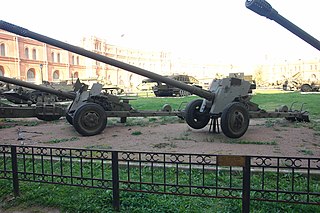
2A19 or T-12 is a Soviet-designed 100-mm anti-tank gun. It was the first anti-tank gun to adopt a smoothbore barrel, and to introduce modern armor piercing shot, like the APFSDS. It uses long projectiles that are more powerful than its caliber suggests. The T-12 served as the primary towed anti-tank artillery in the Soviet and Bulgarian armies from the early 1960s to the late 1980s.
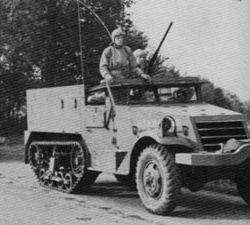
The M2 half-track car was an armored half-track produced by the United States during World War II. Its design drew upon half-tracks imported from France in the 1930s, employing standard components supplied by U.S. truck manufacturers to speed production and reduce costs. The concept was designed, and the pilot models manufactured by the Firestone Tire and Rubber Company Production by the White Motor Company began in 1940 and was expanded to include Autocar.

The 155 mm Gun Motor Carriage M12 was a U.S. self-propelled gun developed during the Second World War. It mounted a 155 mm gun derived from the French Canon de 155mm GPF field gun.
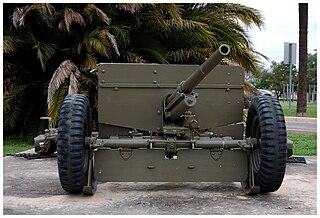
The 37 mm gun M3 is the first dedicated anti-tank gun fielded by United States forces in numbers. Introduced in 1940, it became the standard anti-tank gun of the U.S. infantry with its size enabling it to be pulled by a jeep. However, the continuing improvement of German tanks quickly rendered the 37 mm ineffective and, by 1943, it was being gradually replaced in the European and Mediterranean theaters by the more powerful British-developed 57 mm gun M1. In the Pacific, where the Japanese tank threat was less significant, the M3 remained in service until the end of the war, but some 57mm guns were issued.

The 76 mm gun M1 was an American World War II–era tank gun developed by the U.S United States Ordnance Department in 1942 to supplement the 75 mm gun on the basic Medium tank M4. It was also used to arm the M18 Hellcat tank destroyer.

The 3-inch gun M5 was an anti-tank gun developed in the United States during World War II. The gun combined a 3-inch (76.2 mm) barrel of the anti-aircraft gun T9 and elements of the 105 mm howitzer M2. The M5 was issued exclusively to the US Army tank destroyer battalions starting in 1943. It saw combat in the Italian Campaign and on the Western Front in Northwest Europe.
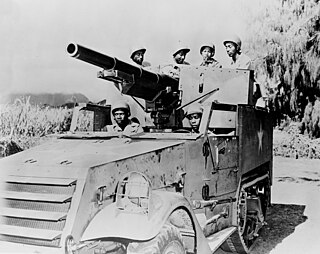
The M3 Gun Motor Carriage (GMC) was a United States Army tank destroyer equipped with a 75 mm M1897A4 gun, which was built by the Autocar Company during World War II.

The tank destroyer battalion was a type of military unit used by the United States Army during World War II. The unit was organized in one of two different forms—a towed battalion equipped with anti-tank guns, or a mechanized battalion equipped with armored self-propelled guns. The tank destroyer units were formed in response to the German use of massed formations of armored vehicles units early in WWII. The tank destroyer concept envisioned the battalions acting as independent units that would respond at high speed to large enemy tank attacks. In this role, they would be attached in groups or brigades to corps or armies. In practice, they were usually individually attached to infantry divisions. Over one hundred battalions were formed, of which more than half saw combat service. The force was disbanded shortly after the end of the war when the concept had been shown to be militarily unsound.
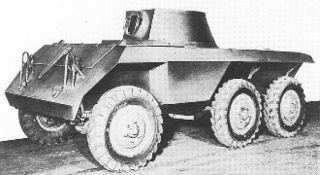
The T23 armored car was an entry from the Fargo Division Chrysler for a new fast tank destroyer to replace the M6 37mm gun motor carriage in July 1941 initiated by the U.S. Army Ordnance Department. Required specification was to be able to withstand fire from a .50 in (12.7 mm) machine gun to the front and side from a .30 in (7.62 mm) machine gun. Although Dwight D. Eisenhower's headquarters were in favor, the design was rejected in favor of the Ford T22.


















